第5讲.倒装句.教师版
- 格式:doc
- 大小:730.64 KB
- 文档页数:12
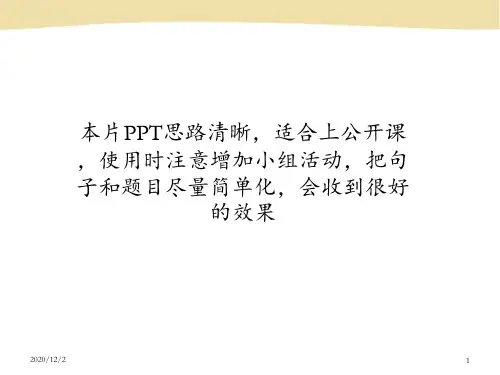
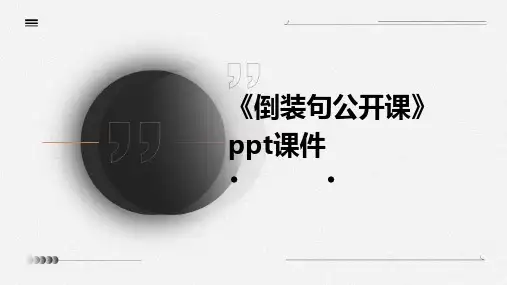
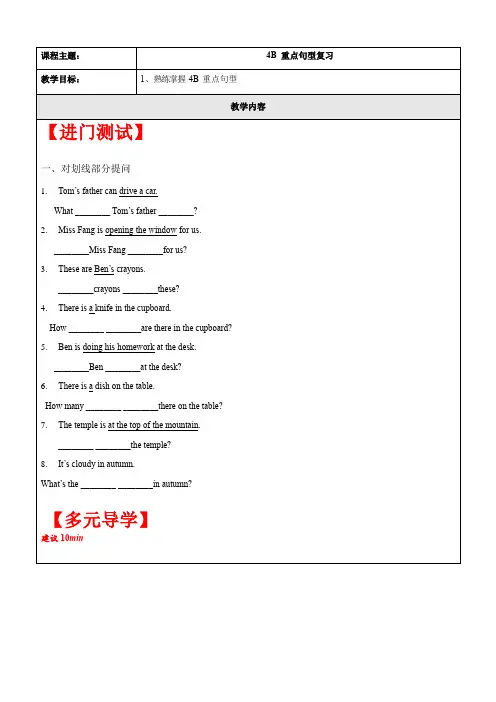
S1: Hi ! Tom, Which season do you like best ?
S2: Hi ! Lucy, .
(我最喜欢冬天。
)
S1: What can you do in winter ?
S2: .
(我可以在夏天游泳。
)
批注:通过情景交际来引出本节课的主要内容:复习4B 每个单元的重点句型。
【互动精讲】
建议70min
一.What 引导的特殊疑问句
What 引导的特殊疑问句在小学四年级中涉及的主要有以下几种提问:
询问“是什么”、询问姓名、询问钟点、询问颜色、询问动物、询问星期、询问能力、询问意愿、询问某人有什么、询问一日三餐、询问课程
【例题精讲】
例1:这是什么?它是一个橡皮。
________________________________________________
例2:你叫什么名字?我的名字是Amy。
________________________________________________
例3:几点了?八点了。
________________________________________________
例4:你的衬衫是什么颜色?是红色的。
________________________________________________。

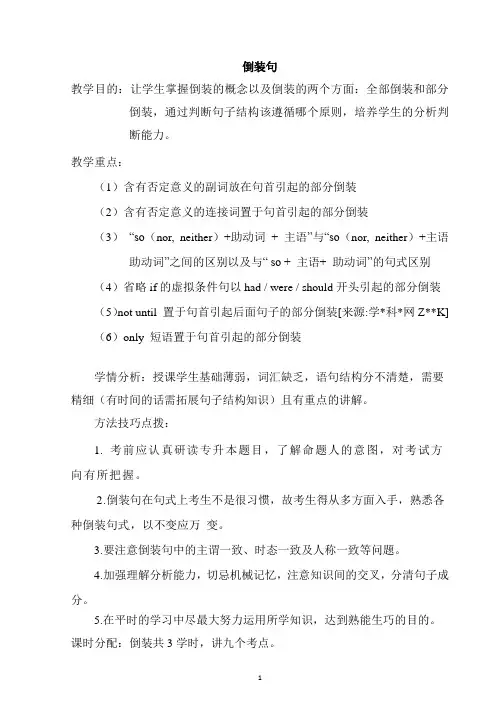
倒装句教学目的:让学生掌握倒装的概念以及倒装的两个方面:全部倒装和部分倒装,通过判断句子结构该遵循哪个原则,培养学生的分析判断能力。
教学重点:(1)含有否定意义的副词放在句首引起的部分倒装(2)含有否定意义的连接词置于句首引起的部分倒装(3)“so(nor, neither)+助动词+ 主语”与“so(nor, neither)+主语助动词”之间的区别以及与“ so + 主语+ 助动词”的句式区别(4)省略if的虚拟条件句以had / were / should开头引起的部分倒装(5)not until 置于句首引起后面句子的部分倒装[来源:学*科*网Z**K] (6)only 短语置于句首引起的部分倒装学情分析:授课学生基础薄弱,词汇缺乏,语句结构分不清楚,需要精细(有时间的话需拓展句子结构知识)且有重点的讲解。
方法技巧点拨:1. 考前应认真研读专升本题目,了解命题人的意图,对考试方向有所把握。
2.倒装句在句式上考生不是很习惯,故考生得从多方面入手,熟悉各种倒装句式,以不变应万变。
3.要注意倒装句中的主谓一致、时态一致及人称一致等问题。
4.加强理解分析能力,切忌机械记忆,注意知识间的交叉,分清句子成分。
5.在平时的学习中尽最大努力运用所学知识,达到熟能生巧的目的。
课时分配:倒装共3学时,讲九个考点。
教学过程:一、考情分析倒装句属于英语中的常用句型,在公共英语中分量不重,每年至多两道题,且考试集中在部分倒装上面。
【知识要点】主语和谓语有两种顺序:一是主语在前,叫自然语序。
反之,如果谓语在主语前就是倒装语序,又分全部倒装和部分倒装。
全部倒装是把全部谓语放在主语之前,部分倒装是把助动词或情态动词放在主语之前。
倒装是一种语法手段,用于表示一定的句子结构或强调某一句子成分。
倒装句有两种:完全倒装和部分倒装。
完全倒装即把整个谓语放到主语之前(是整个谓语动词,而非助动词)。
部分倒装即只把谓语的一部分(如助动词、情态动词等)放到主语前,或把句子的强调成分提前。

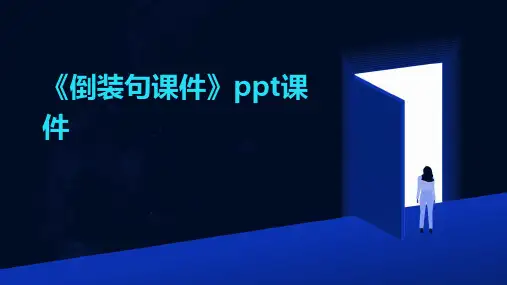




内容基本要求 倒装句1. 语法一致2. 意义一致3. 邻近一致 新概念二第十八课Have 的用法倒装句英语句子通常有两种语序:一种主语在前,谓语在后,称为自然语序;另一种谓语的一部分或整个谓语在前,主语在后,称为倒装语序,如英语的疑问句形式。
在初中阶段倒装句一般都作为特殊句型来处理。
1.倒装句之全部倒装全部倒装是只将句子中的谓语动词全部置于主语之前。
此结构通常只用与一般现在时和一般过去时。
常见的结构有:1) here, there, now, then, thus 等副词置于句首, 谓语动词常用be, come, go, lie, run 。
例:There goes the bell.Then came the chairman.Here is your letter.2) 表示运动方向的副词或地点状语置于句首,谓语表示运动的动词。
例:Ahead sat an old woman.注:上述全部倒装的句型结构的主语必须是名词,如果主语是人称代词则不能完全倒装。
例:Here he comes. Away they went.3)句子的主语较长时(多数情况下又没有宾语),因为要避免头重脚轻的感觉,通常把表语或状语放在句子的前面。
例:In the small box was the ring that he had given her twenty years before.那个小盒里面是那枚他二十年前送给她的戒指。
2. 倒装句之部分倒装部分倒装是指将谓语的一部分如助动词或情态倒装至主语之前。
如果句中的谓语没有助动词或情态动词,则需添加助动词do, does 或did ,并将其置于主语之前。
1) 句首为否定或半否定的词语,如no, not, never, seldom, little, hardly, at no time, in no way, not until… 等。
例:Never have I seen such a performance.Nowhere will you find the answer to this question.Not until the child fell asleep did the mother leave the room.注:如果否定词不在句首不倒装。
例:I have never seen such a performance.第五讲倒装句本讲内容语法考点The mother didn't leave the room until the child fell asleep.3.初中阶段接触到的倒装句型(1)so + be/ 助动词/ 情态动词+主语经常出现在中考试题中。
此句型表示“……也是这样”,用于描述谓语所说情况也适用于另一个人或另一个事物,只能用在肯定句,注意上、下句所使用的动词的时态要一致。
例:You can ride a bike. So can I. 你会骑自行车,我也会。
He has been to Beijing. So have I. 他去过北京,我也去过。
Lin Ping was there last night. So was everyone else in my class.林平昨晚在那里,我们班其他人昨晚也都在那里。
He saw the snake, and so did I. 他看见那条蛇了,我也看到了。
注:上句中前句谓语动词是行为动词,所以后句中要加助动词did。
就像行为动词变疑问句一样,句子如果有be、助动词(如have,will等)和情态动词(如can,must等),就把这些词放在另一个主语前;如果没有,就要加do,does或did。
辨析:so+主语+be/ 助动词/ 情态动词此句型不是倒装句,只是单纯地重复前面一句的意思,表示“的确如此、就是这样”。
例:---My little brother can swim in the sea. 我的小弟弟能在大海了游泳。
---So he can. 的确如此。
---He gets up very early. 他起得真早。
---So he does. 是很早。
(2)neither/ nor + be/ 助动词/ 情态动词+主语经常出现在中考试题中。
此句型表示“……也不这样”。
使用的注意事项和上面的句型1一样。
例:The first one isn’t good, and neither is the second. 第一个不好,第二个也不好。
They didn’t come last night. Nor did I. 他们昨天晚上没有来,我也没有来。
If you don’t go there, neither shall I. 如果你不去那里,我也不去。
注:上句中if引导的条件状语从句用一般现在时表示一般将来时,所以后面的主句用的是一般将来时。
(3)当以there, here, out , in , up , down, away 等副词开头的句子,为了起到强调的作用,可构成倒装句,只把副词放在句首,主语和谓语位置调换,不加助动词。
这时的主语必须是名词。
主语是人称代词时,主语和谓语语序不变。
例:Here comes the bus. 公共汽车来了。
In came our teacher. 我们老师进来了。
Out rushed the boys. 男孩子们冲了出去。
但是:Here it is. 给你。
Away he went. 他走了。
(4)表地点状语的介词短语放在句首,要用倒装句式,以示强调。
这种倒装句也是主谓直接调换位置,不加助动词did, does或do。
例:Under a big tree sat a fat man, half asleep. 树下坐着一个胖男人,似乎睡着了。
(5)there放在句首时,要用倒装句式。
在“there + be”结构中的谓语动词有时不用be , 而用表示“存在”的其他不及物动词。
如:live, stand, come, lie等动词代替be。
例:There came shouts for help from the river. 从河里传来了呼救声。
There lies a large wheat field in front of the house. 房子前面是一大片麦田。
(6)直接引语的全部或一部分放在句首时,动词say等和主语有时倒装。
例:“Well done, Tom.” said our teacher. 老师说:“做得好,汤姆!”(7)only 修饰限定状语需要用到装,例:Only in this way, can you learn English well.Only after being asked three times did he come to the meeting.热身练习一.单项选择1. She plays the piano very well, ______.A. so every one of us doesB. every one of us doesC. so does every one of usD. so do every one of us2. You say he works hard, ______, and _____.A. so he does; so you doB. so he does; so do youC. so does he; so do youD. so does he; so you do3. —I thought you women were present at the meeting. —__________.A. So we wereB. So we didC. So were weD. We did so4. I don’t think Jack will come today, and _____.A. nor will MaryB. and Mary doesn’tC. Mary will eitherD. or Mary does5. She is fond of cooking, _____I.A. so amB. nor amC. neither doD. nor do6. Marx was born in Germany and German was his native language .A. Engles was soB. So was it with EnglesC. So was EnglesD. So did Engles7. He doesn’t like football, neither ______.A. does his parentsB. do his parentsC. his parents don’tD. his parents doKey:CBAAA BB新概念二第19课Sold out'The play may begin at any moment,' I said.'It may have begun already,' Susan answered.I hurried to the ticket office. 'May I have two tickets please?' I asked.'I'm sorry, we've sold out,' the girl said.'What a pity!' Susan exclaimed.Just then, a man hurried to the ticket office.'Can I return these two tickets?' he asked.'Certainly,' the girl said.I went back to the ticket office at once.'Could I have those two tickets please?' I asked.'Certainly,' the girl said, 'but they're for next Wednesday's performance. Do you still want them?''I might as well have them,' I said sadly.1 情态动词(can, could)(希望老师根据课文进行扩充)★2 may + 动词原形:表示可能发生的事情The guests may arrive at any moment. 客人们马上就要来了。